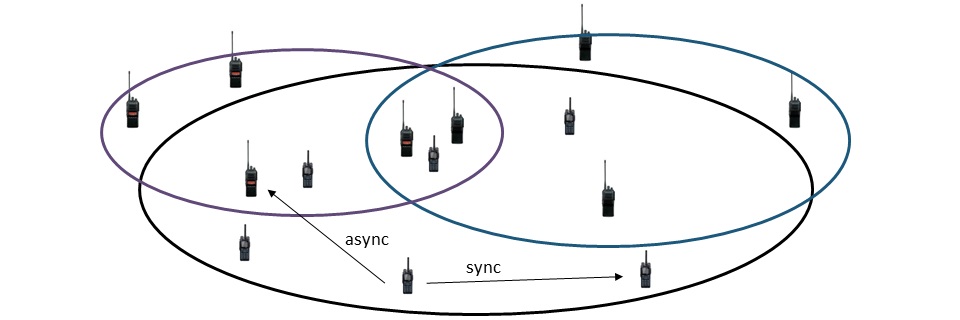The roots of the technology
The wireless communication is one of greatest technologies of our epoch. And there is no matter who you are, - the developer or the consumer, you want to use it. But there is a problem. Two communications cannot be established on the same frequency in the same operating area simultaneously. Because they will create interference with each other and not be operational. Thus, frequency allocation is regulated all over the world and you need to pay for a license that grants to use them. And there are several free unlicensed ISM bands which are most widely used. For example, ISM434 (433.92): 433.05-434.79 MHz.
The easiest solution is a usage of frequency division multiple access (FDMA). Herein, two modern SAW filters which have non-overlapping passband are used to provide two quality connections. So, how are things going in ISM434 range? There is a 1.8MHz band and it is used for transmitting short messages of the maximum bandwidth of 10kHz. And how many different SAW filters with non-overlapped ~10kHz passband on these frequencies are on a market? Only less than 20 varieties which are mass produced. Thus, only 11% (0.2 of 1.8MHz) of ISM434 can be used effectively. Manufacturing of a larger assortment of filters is costly, as well as an installation of several filters in parallel and providing an algorithm for adaptive frequency tuning in the end product. Something is going wrong here. Another solution is needed.
The solution had been found by the Company as a combination of technologies of asynchronous DSSS transceiver and PHY Layer encryption which are realized in software-defined radio (SDR). The transceiver provides the necessary selectivity of signals and PHY Layer encryption provides the necessary variability of possible simultaneous communications on the same frequencies in one operational area.
Our Solution
The main idea of the solution is to establish multiple simultaneous independent asynchronous communications, all of which will occupy a maximum of free ISM band. This idea has realized by means of DSSS-CDMA technique. In this case, all devices that use these frequencies will have the one unified RF frontend that can provide high-quality communications. Signal separation and multi -user/-channel communications are performed by SDR and powered by such techniques and their features:
- PHY Layer encryption that provides 281,475 trillion unique DSSS PHY layer realizations for all devices in IPv6 network, each of these realizations can provide data link of good quality simultaneously with a pair of dozens of the same communications in one operational area;
- asynchronous DSSS receiver that has a spreading factor of 1024/4096; herein, the suppression of signals located in the RF passband:
- narrowband signals (0.1% of the RF passband): >30dB;
- wideband signals (100% of the RF passband), including signals from other transceivers which use this technique but have another PHY layer realization: >15dB;
- wideband signals from transceivers which have the same PHY layer realization during synchronous communication that is led by master device: >30dB.
- Multichannel M-ary BiOrthogonal Keying (MMBOK), the multichannel operation takes place during synchronous transmission of data via several channels to one or multiple devices, in another case (single channel) simple MBOK is used.
Thus, the following types of connections can be established:
- multiple independent asynchronous CDMA P2P (point-to-point) communications;
- single synchronous CDMA P2MP (point-to-multipoint) communications;
- single/multiple asynchronous CDMA P2MP (all-to-all) communications.

Here, the synchronous CDMA communication principles are similar to mobile DSSS-CDMA where master device plays the role of a base station and slave devices - mobile stations. All transmission processes are conducted without synchronization channel or other continuous system synchronization, but all are led by the master device. Here, all devices are united in one network and have equal PHY layer realization.
On the other hand, the asynchronous CDMA communication principles allow multiple simultaneous independent communications in one operational area but limited by signal processing gain for suppressing wideband interference of all other async DSSS-CDMA links. Thus, asynchronous DSSS-CDMA link will be operational if the ratio of a sum of signals from all other links to the desired signal does not exceed 15dB. Such ratio can occur in such extreme cases:
- there are two links of equal power where both of receivers are located in one position and a transmitter of another link is located 6 times closer to receivers than the desirable one;
- there are 32 transmitters which radiate equal power and are located at the same distance from the one receiver that can receive a signal from one transmitter simultaneously.
Operability of such cases are verified in next trials
Trials
Results of trials of this technology are displayed in 2nd part of next video. Time codes of separate tests:
- 5:10 - Asynchronous DSSS-CDMA:
- 5:23 - Two links of equal power, equal distance between transmitters (TXs) and receivers (RXs).
- 8:19 - Two links of equal power, RXs located in one position, distanсe to one of TX is 6 times more than to another.
- 10:27 - Eight links of equal power where TXs are located at equal distance from one RX.
- 14:45 - Synchronous DSSS-CDMA:

